The CBD Skin Care Market is estimated to be valued at USD 5.3 billion in 2025 and is projected to reach USD 46.7 billion by 2035, registering a compound annual growth rate (CAGR) of 24.4% over the forecast period.
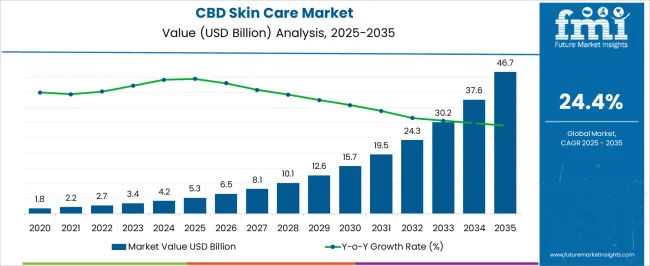
| Metric | Value |
|---|---|
| CBD Skin Care Market Estimated Value in (2025 E) | USD 5.3 billion |
| CBD Skin Care Market Forecast Value in (2035 F) | USD 46.7 billion |
| Forecast CAGR (2025 to 2035) | 24.4% |
The CBD skin care market is experiencing rapid growth. Rising consumer awareness of natural and functional ingredients, increasing demand for wellness-focused personal care products, and ongoing innovations in formulation technologies are driving adoption. Current market dynamics are shaped by expanding distribution networks, regulatory advancements, and growing acceptance of cannabidiol-based products in both mature and emerging markets.
Premiumization trends and rising disposable income are contributing to higher spending on differentiated skin care solutions. Challenges related to regulatory compliance, product standardization, and consumer education are being mitigated through certifications, quality assurance initiatives, and targeted marketing strategies.
The future outlook is characterized by continued product diversification, including multifunctional formulations and advanced delivery systems, along with expansion in online and specialty retail channels Growth rationale is anchored on the perceived therapeutic benefits of CBD, the ability of manufacturers to innovate in textures, ingredients, and application methods, and strategic packaging and branding initiatives that enhance consumer engagement, collectively supporting sustained market expansion and higher adoption across demographics.
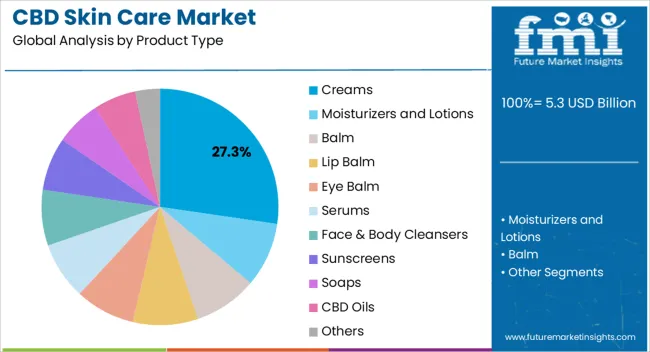
The creams segment, holding 27.30% of the product type category, has been leading due to its versatility and ease of use in topical applications. Adoption has been supported by consumer preference for moisturization and targeted skin benefits, and reliability in delivering active ingredients has reinforced market acceptance.
Formulation improvements, such as enhanced bioavailability and skin penetration, have increased efficacy, while compliance with safety and quality standards has strengthened trust among end-users. Strategic partnerships between manufacturers and dermatology experts have facilitated product validation and credibility.
Ongoing innovation in textures, scents, and multifunctional benefits is expected to maintain segment share, support premium positioning, and contribute to overall market growth.
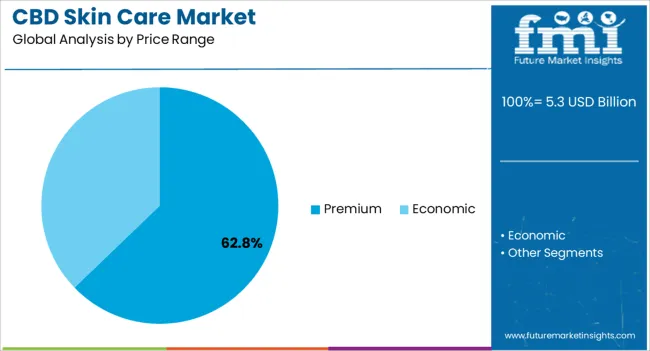
The premium segment, representing 62.80% of the price range category, has maintained prominence due to consumer willingness to invest in high-quality, perceived luxury skin care products. Adoption has been driven by brand positioning, efficacy claims, and packaging aesthetics, which enhance perceived value.
Market confidence has been reinforced by consistent product performance, certifications, and endorsements. Marketing strategies emphasizing exclusivity, sustainability, and wellness benefits have strengthened consumer engagement.
Continued growth is expected through expansion of premium offerings, targeted marketing, and the introduction of limited-edition and value-added products that resonate with affluent consumer segments, thereby sustaining market leadership.
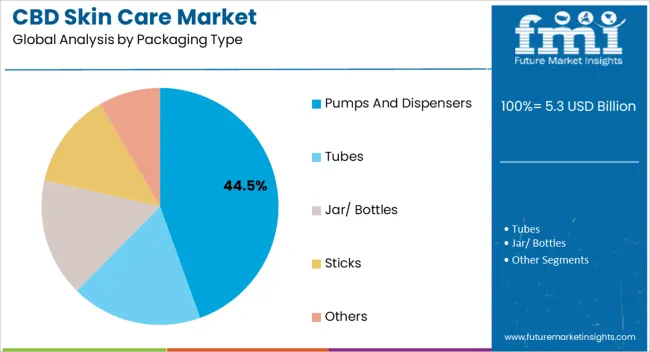
The pumps and dispensers segment, holding 44.50% of the packaging type category, has emerged as the leading packaging format due to convenience, controlled dosage, and hygiene benefits. Adoption has been driven by consumer preference for user-friendly, travel-safe, and aesthetically appealing packaging solutions.
Innovations in pump mechanisms and dispenser designs have enhanced functionality and brand differentiation, while regulatory compliance and material safety have reinforced consumer trust.
Continued focus on sustainable materials, ergonomic design, and packaging customization is expected to support segment growth, maintain market share, and improve overall product appeal in both retail and online channels.
The CBD skin care industry displayed market growth of 18.8% CAGR in the historical period. The growth of the market is expected to assume a pace of 25.7% CAGR over the forecast period due to the buzz around CBD skin care products.
The market has been driven by the increasing number of working professionals, which has expanded the spending capacity and awareness about several products present in the market, which is thus boosting the sales of quality products.
| Attributes | Details |
|---|---|
| CBD Skin Care Market Size (2020) | USD 1,353 million |
| CBD Skin Care Market Size (2025) | USD 2,696 million |
| CBD Skin Care Market CAGR (2020 to 2025) | 18.8% |
In the upcoming years, manufacturers are expected to develop clean-label personal care products. Due to the increasing options available to consumers, manufacturers are focusing on developing affordable and reliable products to boost their sales.
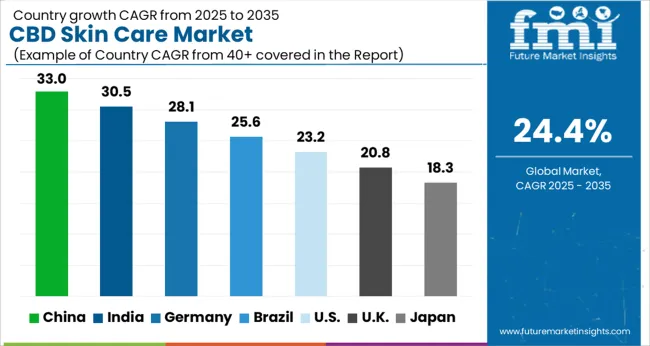
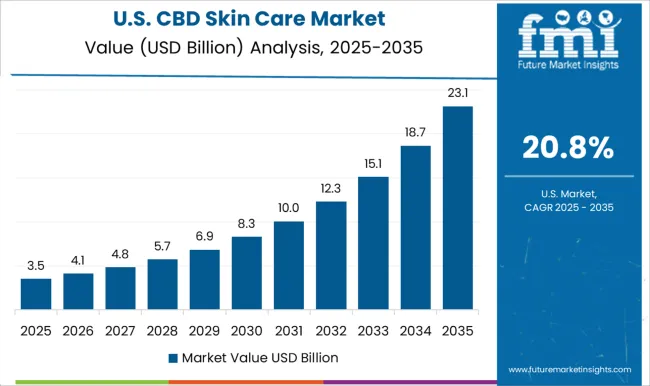
The CBD skin care market in North America is at an all-time high. The CBD skin care market in the United States accounts for 31.1%, thus gaining a massive share of the global market. The high presence of CBD skin care product manufacturers like DR. KERKLAAN THERAPEUTICS, Cannuka, LLC, Redwood Wellness, LLC, SAGELY NATURALS, etc., is influencing the market positively in the country.
Another chief factor fueling the market growth is the legalization of sales of cannabis-based products in the United States. This is projected to create a considerable demand for hemp-derived CBD skin care products in the country. Skin care products containing marijuana-derived CBD are selling like hotcakes due to growing awareness about their benefits. These products are beneficial in treating acne and slowing down aging.
This magic ingredient has become a norm in several skin care products like moisturizers, cleansers, sunscreens, chapsticks, etc. Thus, the growing familiarity of American inhabitants with CBD-infused skin care products has a significant role in boosting their consumption.
Canada is another key market in North America, which is assessed to account for 6% of the global market. Businesses are finding significant expansion opportunities in the country, after the positive outcome of their business in the United States.
Apart from this, the fact that CBD has been positioned as a hero ingredient in beauty products has a crucial role in attracting potential customers. Moreover, companies are invigorating their distribution networks to boost the accessibility of CBD skin care products.
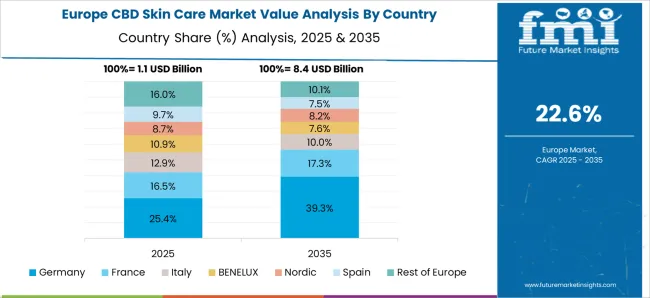
Leading vendors are investing in the Germany market due to the high potential for revenue over the upcoming years. Consumers in Germany are showing greater concern for the ingredients used in their skin products. Therefore, companies are emphasizing developing innovative and more sustainable CBD skin care products for an enormous uptake.
CBD is finding higher adoption in skin care products, as it offers the benefits of cannabis without any psychoactive effects associated with cannabis. Owing to this, consumers who either cannot or will not utilize conventional marijuana products are expected to opt for CBD skin care products. Due to the widespread use of CBD in many industries, including skincare and makeup, dispensary owners are finding significant opportunities for expansion and lucrative turnover.
The United Kingdom accounts for 8.1% market share across the globe. The country holds the maximum share of the Europe CBD skin care market. Due to its high lucrativeness for the CBD skin care business, numerous manufacturers are projected to launch their CBD skin care products in the country, thus boosting skincare market growth.
Asia Pacific is an emerging hub for beauty products, thanks to the appearance-conscious Asian population in the region. The increasing number of working women in the region is directly impacting the sales of beauty products. Interest in green cosmetic products is also soaring as consumers in China are gravitating toward sustainable fashion.
As per the latest market estimates, China is projected to have a prominent stake in the region. Surging consumer awareness about the benefits of natural cosmetics and the increasing emphasis of domestic players on the development of innovative and effective products composed of natural ingredients are boosting the market demand.
| Country | Market Share, 2025 |
|---|---|
| China | 4.4% |
| India | 3.1% |
| Japan | 2.2% |
| Singapore | 1.1% |
The China market holds a 4.4% of value share in the global market. The CBD beauty trend is gradually catching up in China, which has made a prominent name for itself as one of the leading beauty markets in the globe.
After the cannabis legalization in Europe and North America, skin care manufacturers have been increasingly deploying CBD in skincare products to enrich them with immunity-restorative and anti-inflammatory properties. Consequently, CBD has achieved a reputation as a star ingredient in the broader wellness beauty movement.
Such massive popularity of CBD in the West has grabbed the attention of trend-savvy consumers in China. Beauty and fashion bloggers in China are utilizing CBD product shopping hauls as a content staple for their social media handles.
Daigous, referred to as the overseas personal shoppers in China, has been actively sourcing CBD beauty products to sell back to homeland consumers who recognize themselves as international, sophisticated, and cosmopolitan.
| Top Product Type | Creams and Moisturizers |
|---|---|
| Market Share, 2025 | 12.4% |
The CBD-based creams and moisturizers segment has a share of 12.4% of the global market. Spurring sales of beauty products due to heightened skin concerns and consumer demand for distinct moisturizing creams are catalyzing market growth. Consumers are now open to experimenting with new and innovative products in the market, thus prompting manufacturers to develop creams and moisturizers with new ingredients.
As the anti-wrinkle ingredient products, skin-lightening products, and effective moisturizing products are rising, sales and revenue generated from these products in creams and moisturizer formats are escalating.
| Top Packaging Type | Pumps and Dispensers |
|---|---|
| Market Share, 2025 | 23.4% |
Consumers are increasingly opting for CBD skin care products packed in pumps and dispensers. Their high adoption of beauty products in these formats can be credited to the high-end features of pumps and dispensers like being easy to dispose of, lightweight, chemical resistant, and likewise. Top manufacturers of pumps and dispensers are launching more eco-friendly products composed of 100% recycled contents and bioplastic for their eco-conscious consumers.
Packaging developers are introducing innovations in the market such as airless pumps to enhance product preference. The growing focus on the cost-efficiency of packaging products for higher margins is expected to boost the segment’s growth.
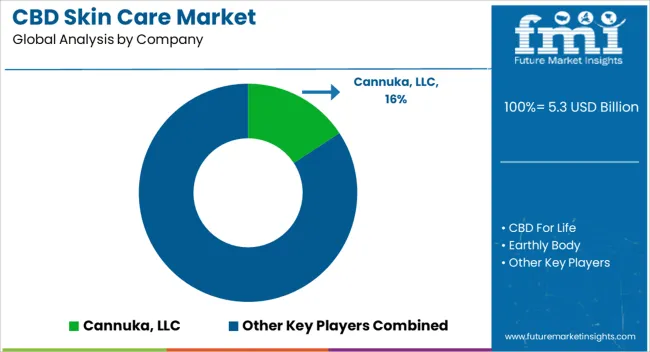
CBD skin care products market manufacturers are focusing on launching CBD-based products in their portfolios. For their enhanced accessibility, players are invigorating their distribution channels and online presence. A key differentiation strategy among the leading players includes cost-competitiveness.
New launches, partnerships, collaborations, and mergers and acquisitions are some of the typical strategies adopted by leading players for better market penetration.
Key Developments in the CBD Skin Care Market
The global CBD skin care market is estimated to be valued at USD 5.3 billion in 2025.
The market size for the CBD skin care market is projected to reach USD 46.7 billion by 2035.
The CBD skin care market is expected to grow at a 24.4% CAGR between 2025 and 2035.
The key product types in CBD skin care market are creams, moisturizers and lotions, balm, lip balm, eye balm, serums, face & body cleansers, sunscreens, soaps, CBD oils and others.
In terms of price range, premium segment to command 62.8% share in the CBD skin care market in 2025.






Full Research Suite comprises of:
Market outlook & trends analysis
Interviews & case studies
Strategic recommendations
Vendor profiles & capabilities analysis
5-year forecasts
8 regions and 60+ country-level data splits
Market segment data splits
12 months of continuous data updates
DELIVERED AS:
PDF EXCEL ONLINE
CBD-Infused Skincare Market Size and Share Forecast Outlook 2025 to 2035
CBD Oil Market Size and Share Forecast Outlook 2025 to 2035
CBD Snacks Market Size and Share Forecast Outlook 2025 to 2035
CBD Gummies Market Analysis - Size, Share and Forecast Outlook 2025 to 2035
CBD Product Packaging Market Size and Share Forecast Outlook 2025 to 2035
Competitive Overview of CBD Product Packaging Market Share
USA CBD Gummies Market Trends – Growth, Demand & Innovations 2025-2035
Pet CBD Market
ASEAN CBD Gummies Market Growth – Trends, Demand & Innovations 2025-2035
Europe CBD Gummies Market Insights – Size, Share & Industry Trends 2025-2035
Flavored CBD Powder Market Growth - Innovations & Consumer Trends 2025 to 2035
Cannabidiol CBD Pet Market Size and Share Forecast Outlook 2025 to 2035
Skin Lightening Product Market Size and Share Forecast Outlook 2025 to 2035
Skin Tightening Device Market Size and Share Forecast Outlook 2025 to 2035
Skin-Barrier Strengthening Phospholipids Market Size and Share Forecast Outlook 2025 to 2035
Skin Toner Market Size and Share Forecast Outlook 2025 to 2035
Skin Cancer Detection Devices Market Size and Share Forecast Outlook 2025 to 2035
Skin Sensors Market Size, Growth, and Forecast for 2025 to 2035
Skin Grafting System Market Size and Share Forecast Outlook 2025 to 2035
Skin Perfusion Pressure Testing Devices Market Size and Share Forecast Outlook 2025 to 2035

Thank you!
You will receive an email from our Business Development Manager. Please be sure to check your SPAM/JUNK folder too.
Chat With
MaRIA